 ...........................................................................................................
...........................................................................................................
The Aegean Mesolithic and the transition
to the Early Neolithic
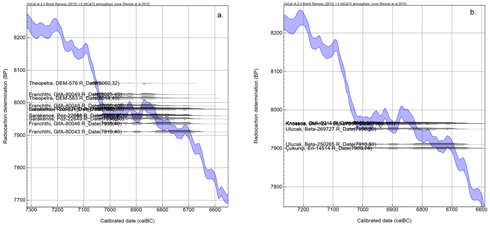
Franchthi
Among the most representative radiocarbon sequences extending from the Mesolithic to the Neolithic is the sequence from the cave of Franchthi. It includes dates from the Lower Mesolithic (Lithic Phases VI–VII: 8700–8300 calBC), the Upper Mesolithic (Lithic Phase VIII: 8300–7600) and the Final Mesolithic (Lithic Phase IX: 7100–6600 calBC). A major gap between 7600 and 7100 calBC separates Lithic Phases VIII and IX (Figure 2).
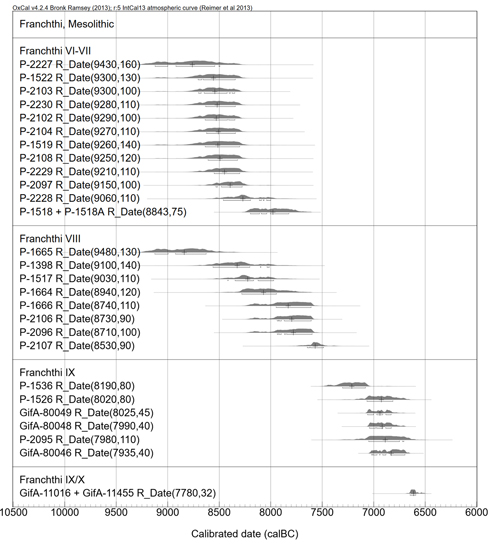
The dates for the Neolithic span the period between c. 6700 and 5000 calBC with a short early phase between 6700 and 6400 calBC followed by a major gap of up to 500 years (compare Analysis of Subregion IIb).
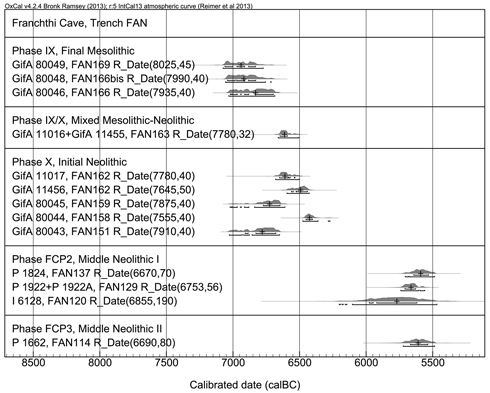
Unclear and therefore subdued to different interpretations is the disturbed stratigraphic evidence at the transition from the Final Mesolithic to the "Initial Neolithic", Lithic Phases IX, IX/X and X. Essential for the establishment of the radiocarbon sequence at the transition from the Mesolithic to the Neolithic are the recently published dates on grains (Perlès et al. 2013). They derive especially from trench FAN with the least disturbed stratigraphic record (Figure 3). Since only samples from a continuous stratigraphical sequence can be used in a model and not samples from trenches without connections or even from disturbed areas, this sequence in trench FAN serves well for the creation of a boundary model. Two slightly different models shall be presented for Phases IX and X, depending on whether the grains from unit FAN:163 belong to Phase IX (version 1, Figure 4a) or to Phase X (version 2, Figure 4b).
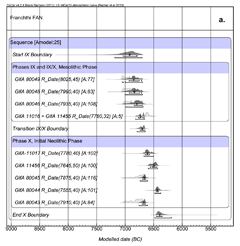
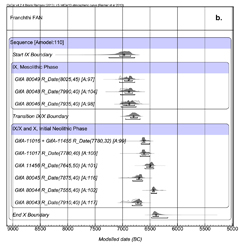
Given the poor agreement in version a, it is version b that appears to be the more probable one. This appraisal is supported by the new dates from the cave of Sarakenos with a median value at 6650 calBC for the start of Unit 3 (compare Figure 5).
Other Aegean sites with Mesolithic occupation episodes
The Mesolithic sequence from Sarakenos near Akraephnion, Boeotia, can be dated to anywhere between 7050 and 6700 calBC (in the 1σ range), with median values around 6850 calBC. The Neolithic sequence starts after 6700 calBC and ends at 6250 calBC (in the 1σ range) with median values between 6650 and 6350 calBC (Figure 5). Also in the Cave of Theopetra does the boundary from the Mesolithic to the Neolithic fall within the time-span of the plateau (Figure 6), whereas in the sequence from the Cyclops Cave on Youra it is exactly this period that is not represented (Figure 7).
The lack of Mesolithic sites from the eastern Aegean should not be taken as a lack of evidence: Recently, in Girmeler Mesolithic layers were described (Takaoğlu et al. 2014) as were also for the open-air site of Kerame on the island of Ikaria (Sampson et al. 2012). For an Analysis of the Neolithic sequences from the eastern Aegean compare Subregion IIa.
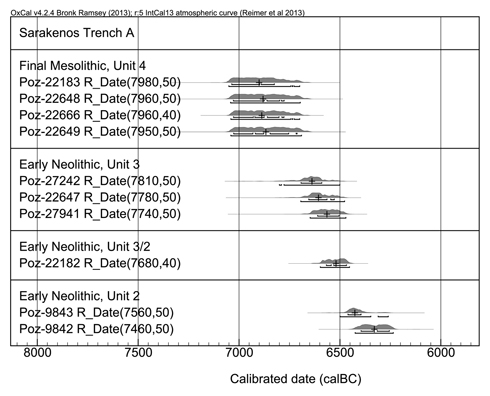
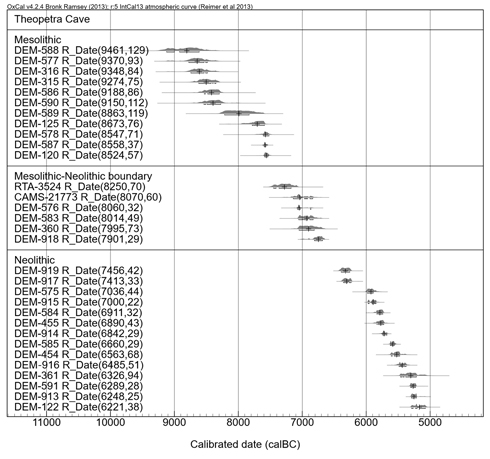
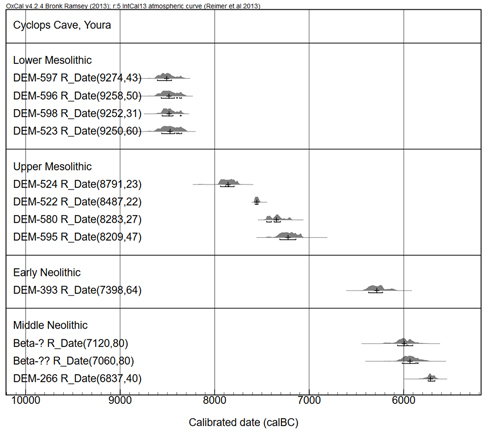
to the Early Neolithic
The Aegean Mesolithic has until the late 1990s been regarded as insignificant: J. Cherry envisaged in 1981 the colonisation of presumably uninhabited Aegean islands, a concept that was transferred subsequently also to the Greek mainland (Perlès 1990; Perlès 2003, 99–113). After 1996 many new sites were discovered and investigated, both in western (Runnels und van Andel 2003) and in eastern Greece (Sampson 1998; Sampson et al. 1998; Kaczanowska and Kozłowski 2015). These new insights have changed essentially our view on Aegean prehistory and the transition from the Mesolithic to the Neolithic period in this area: The participation of the local Mesolithic population in the transformation process called Neolithisation must, hence, be re-considered. A starting point for a re-evaluation are given by the 14C dates, especially those from the Argolid (Franchthi), Boeotia (Sarakenos), western Thessaly (Theopetra) and the Northern Sporades (Youra).
Wiggles and plateaus on the calibration curve
Impeding a more precise limiting of both the beginning and the end of the Final Mesolithic period in the Aegean are the many wiggles forming so-called plateaus on the calibration curve. Especially the plateau at the end of the Mesolithic / beginning of the Neolithic is spanning several centuries, approximately the time between 7000 and 6700 calBC. It affects not only the dates from the Mesolithic occupation in caves (Franchthi, Sarakenos, Theopetra: Figure 1a) but also those from Neolithic settlements, e.g. Çukuriçi Höyük, Ulucak and Knossos (Figure 1b) – compare Analysis of Subregions IIa and IIb. This situation has to be born in mind when discussing the transition between the two periods.
Wiggles and plateaus on the calibration curve
Impeding a more precise limiting of both the beginning and the end of the Final Mesolithic period in the Aegean are the many wiggles forming so-called plateaus on the calibration curve. Especially the plateau at the end of the Mesolithic / beginning of the Neolithic is spanning several centuries, approximately the time between 7000 and 6700 calBC. It affects not only the dates from the Mesolithic occupation in caves (Franchthi, Sarakenos, Theopetra: Figure 1a) but also those from Neolithic settlements, e.g. Çukuriçi Höyük, Ulucak and Knossos (Figure 1b) – compare Analysis of Subregions IIa and IIb. This situation has to be born in mind when discussing the transition between the two periods.

Figure 1. Plateau in the calibration curve between 7000 and 6700 BC impeding a more precise limitation of the final Mesolithic (a) and earliest Neolithic (b) stages.
Franchthi
Among the most representative radiocarbon sequences extending from the Mesolithic to the Neolithic is the sequence from the cave of Franchthi. It includes dates from the Lower Mesolithic (Lithic Phases VI–VII: 8700–8300 calBC), the Upper Mesolithic (Lithic Phase VIII: 8300–7600) and the Final Mesolithic (Lithic Phase IX: 7100–6600 calBC). A major gap between 7600 and 7100 calBC separates Lithic Phases VIII and IX (Figure 2).

Figure 2. The Mesolithic sequence from Franchthi (dates are arranged according to phases and ages).
The dates for the Neolithic span the period between c. 6700 and 5000 calBC with a short early phase between 6700 and 6400 calBC followed by a major gap of up to 500 years (compare Analysis of Subregion IIb).

Figure 3. The Mesolithic and Neolithic sequences from Franchthi, trench FAN (dates are arranged according to phases and units).
Unclear and therefore subdued to different interpretations is the disturbed stratigraphic evidence at the transition from the Final Mesolithic to the "Initial Neolithic", Lithic Phases IX, IX/X and X. Essential for the establishment of the radiocarbon sequence at the transition from the Mesolithic to the Neolithic are the recently published dates on grains (Perlès et al. 2013). They derive especially from trench FAN with the least disturbed stratigraphic record (Figure 3). Since only samples from a continuous stratigraphical sequence can be used in a model and not samples from trenches without connections or even from disturbed areas, this sequence in trench FAN serves well for the creation of a boundary model. Two slightly different models shall be presented for Phases IX and X, depending on whether the grains from unit FAN:163 belong to Phase IX (version 1, Figure 4a) or to Phase X (version 2, Figure 4b).


| Figure 4a. Franchthi, modelled dates from trench FAN (with sample from unit FAN:163, R_combine GifA-11016 + GifA-11455, modelled together with dates from Phase IX) resulting in poor agreement (Amodel:25). | Figure 4b. Franchthi, modelled dates from trench FAN (with sample from unit FAN:163, R_combine GifA-11016 + GifA-11455, modelled together with dates from Phase X) resulting in good agreement (Amodel:110). |
| Transition Mesolithic–Neolithic |
Version a (calBC 1σ) (Amodel:25) |
Version a Median values |
Version b (calBC 1σ) (Amodel:110) |
Version b Median values |
| Franchthi IX (IX–X) | 7050–6650 | 6920–6700 | 7050–6730 | 6960–6800 |
| Franchthi (IX–X) X | 6650–6350 | 6700–6400 | 6650–6350 | 6600–6400 |
Table 1. Summary based on the boundaries and medians of the modelled versions (compare Figures 4a and 4b).
Given the poor agreement in version a, it is version b that appears to be the more probable one. This appraisal is supported by the new dates from the cave of Sarakenos with a median value at 6650 calBC for the start of Unit 3 (compare Figure 5).
Other Aegean sites with Mesolithic occupation episodes
The Mesolithic sequence from Sarakenos near Akraephnion, Boeotia, can be dated to anywhere between 7050 and 6700 calBC (in the 1σ range), with median values around 6850 calBC. The Neolithic sequence starts after 6700 calBC and ends at 6250 calBC (in the 1σ range) with median values between 6650 and 6350 calBC (Figure 5). Also in the Cave of Theopetra does the boundary from the Mesolithic to the Neolithic fall within the time-span of the plateau (Figure 6), whereas in the sequence from the Cyclops Cave on Youra it is exactly this period that is not represented (Figure 7).
The lack of Mesolithic sites from the eastern Aegean should not be taken as a lack of evidence: Recently, in Girmeler Mesolithic layers were described (Takaoğlu et al. 2014) as were also for the open-air site of Kerame on the island of Ikaria (Sampson et al. 2012). For an Analysis of the Neolithic sequences from the eastern Aegean compare Subregion IIa.
—A.R.

Figure 5. Calibrated dates from Trench A in the cave of Sarakenos, western Aegean.

Figure 6. Sequence of radiocarbon dates from Theopetra in Thessaly, western Aegean region (dates are arranged according to periods and ages).

Figure 7. Charcoal and bone samples from the Cyclops Cave on Youra, Northern Sporades, western Aegean region (dates are arranged according to periods and ages).



 up
up